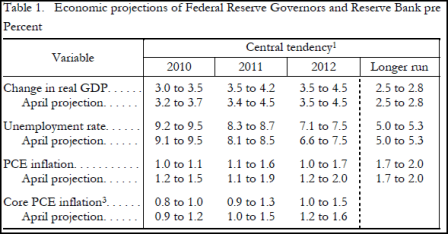[Skip to the end]
A bit disorganized, but these are my impressions as of month end.
(Look for the usual couple of days or so of month end allocations driving the technicals.)
I don’t see much to get encouraged about on almost all of these charts.
In general, demand was trending lower since maybe mid 2006, took a sharp dip in mid 2008 with the great Mike Masters Inventory Liquidation that ended in late Dec 2008, after which the rate of decline stopped accelerating (second derivative change), and now were are, for the most part, back on the ‘trend line’ of the slow decline in demand that started in mid 2006.
Personal income looks very weak, hurt by falling interest income as previously discussed. The clunker lift has reversed, and housing remains very week with no real signs of recovery yet. (about 2% of GDP was clunkers and inventories)
The deficit got large enough due to the automatic stabilizers around year end, market functioning returned as the Fed eventually accepted enough different kinds of collateral from its banks to adequately fund them. (should have been lending unsecured to its member banks all along, etc.)
But while the Obama fiscal package added some demand, and GDP stabilized, the zero interest rate policy continued to shift savings incomes to widening bank net interest margins, and the Fed’s $2 T portfolio began draining another maybe 60 billion a year in private sector interest income. Additionally, interest rates on tsy secs have declined sharply with the Fed rate cuts. (While I fully support a zero rate policy I also recognize the need to sustain demand with a payroll tax holiday, per capita revenue sharing, and an $8/hr fed funded job for anyone willing and able to work.)
And now with productivity higher than real GDP growth, employment continues to fall, though at a lower rate, and capacity utilization in general remains at very low levels. Prices remain very weak, apart from gold, which could be a bubble driven by the misconception that the Fed’s ‘quantitative easing’ policy is inflationary. In fact, it’s nothing but an asset shift that modestly reduces term interest rates at the cost of draining billions in interest income from the private sector.
If gold does turn out to have been a bubble and collapse, it could be highly demoralizing as it would reveal the Fed does not have the tools to ‘reflate’ at will. Dollar shorts could start covering, further taking away the bid from stocks (also as previously discussed). And if the Saudis have left the prices to their refiners below current levels, crude and products will fall as well.
All major foreign govts. seem to be continuing to favor export led growth, which will also keep US domestic demand in check.
And, in general, it looks like most of the world is looking to tighten up fiscal policy, believing in the like of the ‘debt trap’ and also that monetary policy is expansionary and inflationary.
[top]


